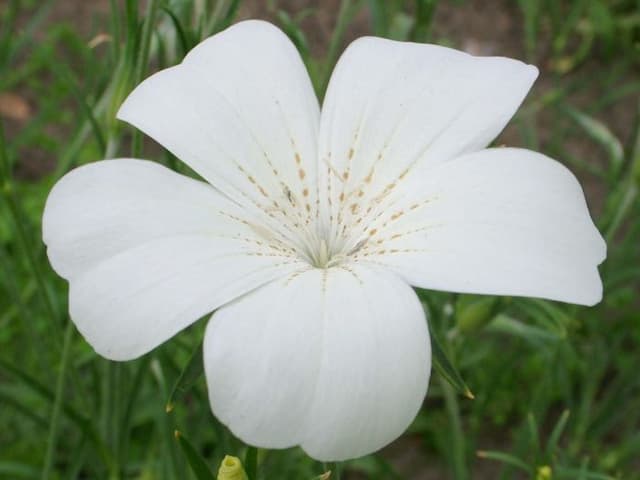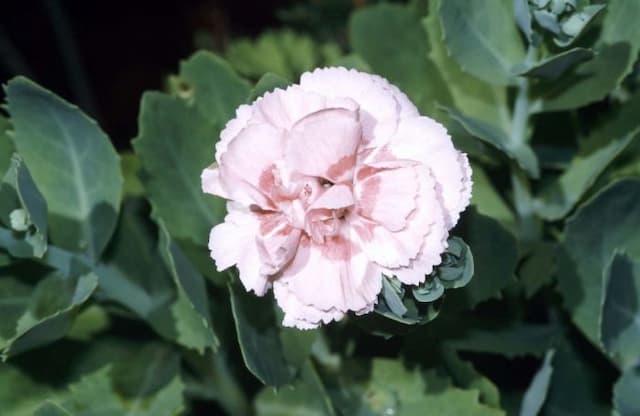Ragged Robin Lychnis flos-cuculi Jenny = 'Lychjen' (d)
![ragged robin [Jenny]](/_next/image?url=https%3A%2F%2Fplants-admin.emdemapps.com%2Fimages%2Fplants%2F%2Fimages%2F604b5767e0c1c.png&w=3840&q=75)
ABOUT
Lychnis flos-cuculi Jenny, commonly known as Ragged Robin, is an ornamental plant noted for its striking flowers and foliage. The flowers are the most distinctive feature, characterized by their frilly or "ragged" appearance. These blooms have a delicate, feathery look and are often a soft pink color, which can range from pale to a more intense pink hue. Each flower is composed of narrow petals that are deeply cut and lobed, giving them a ragged outline that is quite eye-catching. The leaves of the Ragged Robin are typically green, providing a lush background for the flowers. The plant's foliage can be described as lance-shaped or elongated with smooth or slightly hairy surfaces, depending on the variety. These leaves may grow in a basal rosette at the base of the plant as well as alternately along the stems. Overall, the Ragged Robin's appearance is defined by its distinctive ragged-edged flowers that stand out against the greenery of its foliage, creating a visually appealing contrast that makes it popular in gardens and naturalized areas.
About this plant
 Names
NamesFamily
Caryophyllaceae
Synonyms
Ragged Robin, Jenny's Pink
Common names
Silene flos-cuculi (L.) Greuter & Burdet, Lychnis flos-cuculi L.
 Toxicity
ToxicityTo humans
Ragged Robin is the common name for Lychnis flos-cuculi. There is limited information on the toxicity of Ragged Robin to humans, indicating that it is not commonly known to be toxic. No severe symptoms of poisoning have been widely reported upon ingestion. However, as with any plant, individual allergies and reactions can occur. It is always advisable to avoid ingesting plants that are not specifically grown or recognized as food crops, as they may cause negative reactions such as gastrointestinal discomfort or allergic responses.
To pets
Ragged Robin is the common name for Lychnis flos-cuculi. This plant is not widely known to be toxic to pets. There is limited information available regarding its toxicity in animals, suggesting that it is not commonly regarded as a poisonous plant. However, as with any plant, ingestion can sometimes lead to gastrointestinal upset in pets, such as vomiting or diarrhea, especially if large quantities are consumed. It is always best to prevent pets from ingesting plants not intended for consumption to avoid any potential adverse effects.
 Characteristics
CharacteristicsLife cycle
Perennials
Foliage type
Deciduous
Color of leaves
Green
Flower color
Pink
Height
1-2 feet (30-60 cm)
Spread
1-2 feet (30-60 cm)
Plant type
Herb
Hardiness zones
Varies
Native area
Europe
Benefits
 General Benefits
General Benefits- Attracts Wildlife: Lychnis flos-cuculi Jenny, commonly known as Ragged Robin, is known for attracting bees, butterflies, and other beneficial insects, which are essential for pollination in the garden.
- Low Maintenance: Ragged Robin is relatively easy to care for and does not require much attention, making it ideal for gardeners seeking low-maintenance plants.
- Drought Tolerant: Once established, it has good drought tolerance, which means it can survive in drier conditions and requires less watering.
- Aesthetic Appeal: With its distinctive, ragged pink blooms, it adds a unique texture and pop of color to garden beds and borders.
- Naturalizing: Ragged Robin can spread and naturalize in an area, creating a charming, wildflower meadow aesthetic over time.
- Cold Hardy: It is tolerant of cold temperatures and can survive in cooler climates, making it a versatile plant for different garden zones.
- Seasonal Interest: This plant blooms in the late spring to early summer, providing seasonal interest during a time when many other plants are not in flower.
- Height Variation: Its upright habit and height variation add vertical interest to a garden landscape.
 Medical Properties
Medical PropertiesThis plant is not used for medical purposes.
 Air-purifying Qualities
Air-purifying QualitiesThis plant is not specifically known for air purifying qualities.
 Other Uses
Other Uses- Artistic inspiration - Ragged Robin's unique petal shape and vibrant colors can offer inspiration to artists and nature photographers.
- Educational tool - Botany teachers can use Ragged Robin to demonstrate the structure and adaptation of wetland plants in their natural habitat.
- Craft material - The dried flowers of Ragged Robin can be used in floral arrangements, wreaths, and other decorative crafts.
- Garden aesthetics - Ragged Robin can be planted for its wildflower beauty to enhance the aesthetics of both formal and informal gardens.
- Wildlife attraction - Ragged Robin is known to attract butterflies and bees, providing a natural way to support pollinator populations.
- Soil erosion control - When planted in large numbers, Ragged Robin can help to stabilize soil and prevent erosion in wetland areas.
- Eco-friendly confetti - Dried petals of Ragged Robin can serve as a natural and biodegradable option for confetti at celebrations.
- Dye production - Although not commonly known, Ragged Robin petals could potentially be used to create natural dyes for fabrics or crafts.
- Culinary decoration - Edible parts of Ragged Robin can be used as a decorative element for plating in high-end culinary presentations (Note: Only consume plants known to be safe and free of pesticides).
- Environmental indicators - The presence of Ragged Robin in the wild can indicate a healthy and unpolluted wetland ecosystem.
Interesting Facts
 Feng Shui
Feng ShuiRagged Robin is not used in Feng Shui practice.
 Zodiac Sign Compitability
Zodiac Sign CompitabilityRagged Robin is not used in astrology practice.
 Plant Symbolism
Plant Symbolism- Devotion: Lychnis flos-cuculi, commonly known as Ragged Robin, is often associated with feelings of intense dedication and loyalty, symbolizing a commitment that remains steadfast through adversity.
- Youthful Love: The delicate and playful appearance of the Ragged Robin's flowers can represent the innocence and freshness of young love, capturing the essence of new relationships blossoming.
- Ardent Affection: The bright and attractive flowers of Ragged Robin have historically been used to convey deep affection, symbolizing a passionate love that is both conspicuous and fervent.
- Health and Vitality: The robust nature and ability of Ragged Robin to thrive in various conditions can symbolize wellness and the importance of caring for one's health and enduring through challenges.
- Connecting with Nature: Ragged Robin, being a flower that grows wildly in meadows, symbolizes the desire to maintain a close relationship with the natural world, embracing its untamed beauty and diversity.
 Water
WaterRagged Robin should be watered thoroughly to ensure the soil is moist but not waterlogged, this is usually achieved with around 1 inch of water per week. During the growing season in spring and summer, it may need watering twice a week, especially if the weather is dry. However, it's crucial to reduce watering in the fall and winter to prevent root rot, sticking to once every two weeks or even less if the soil remains wet. Always check the top inch of soil for dryness before watering again.
 Light
LightRagged Robin thrives best in full sun to partial shade conditions. A spot that receives morning sunlight and dappled afternoon shade would be ideal to promote healthy growth while protecting the plant from the intense heat of the midday sun. Adequate light is necessary for the plant to develop its characteristic vibrant flowers.
 Temperature
TemperatureRagged Robin is adaptable and can withstand a range of temperatures, but it prefers a temperate climate. It can survive minimum temperatures down to around 20 degrees Fahrenheit and is comfortable in the typical garden environment where the temperature doesn't exceed 90 degrees Fahrenheit. Its ideal growing conditions are between 60 and 75 degrees Fahrenheit.
 Pruning
PruningRagged Robin benefits from deadheading to encourage further blooming and to maintain plant vigor. It should be pruned immediately after the first flowering is over, usually in late spring or early summer. Remove spent flowers and any dead or diseased foliage to promote healthy growth. Further light pruning can be conducted as needed through the growing season to keep the plant tidy.
 Cleaning
CleaningAs needed
 Soil
SoilRagged Robin prefers moist, well-draining soil with a neutral to slightly alkaline pH. A mix of loam, peat, and sharp sand can provide the ideal texture and nutrients. Aim for a pH range between 6.0 and 7.5 for optimal growth.
 Repotting
RepottingRagged Robin does not typically require frequent repotting. Repot every 2-3 years or when it outgrows its current container to maintain soil health and accommodate root growth.
 Humidity & Misting
Humidity & MistingRagged Robin thrives best in average to high humidity environments. Aim for humidity levels between 50% and 70% to replicate the plant's natural damp meadow habitat.
 Suitable locations
Suitable locationsIndoor
Use bright, indirect light and moist soil.
Outdoor
Plant in partial shade, moist soil, protect from strong winds.
Hardiness zone
4-8 USDA
 Life cycle
Life cycleRagged Robin 'Lychjen' begins its life as a seed, which germinates in late winter to early spring when soil temperatures and moisture levels are conducive to sprouting. Emerging seedlings develop into rosettes of foliage, establishing a strong root system. As temperatures increase in late spring to early summer, the plant transitions into a vegetative growth phase, producing stems and leaves. It enters the flowering stage in late spring or early summer, where it displays its distinctive ragged pink flowers, attracting pollinators such as bees and butterflies. After pollination, the flowers develop into seed capsules, which ripen and eventually release seeds in late summer to autumn. These seeds can persist in the soil seed bank or germinate in the following seasons, continuing the lifecycle of the Ragged Robin 'Lychjen'.
 Propogation
PropogationPropogation time
Spring-early summer
Propogation: The most popular method of propagating Lychnis flos-cuculi Jenny, commonly known as Ragged Robin, is by division. Division is best done in the spring or autumn when the plant is not in full flower. To propagate by division, carefully dig up the entire clump and gently separate the root ball into smaller sections, each with a good root system and several shoots. These individual divisions can then be immediately replanted in well-prepared soil, ensuring they are spaced at least 12 inches (approximately 30 centimeters) apart to allow room for growth. Keep the transplanted divisions well-watered until they are established. This method is effective for maintaining the health and vigor of the plants, as well as for multiplying the number of plants in your garden.








![Pink [Bubblegum]](/_next/image?url=https%3A%2F%2Fplants-admin.emdemapps.com%2Fimages%2Fplants%2F%2Fimages%2F604b596f31cbb.png&w=640&q=75)
